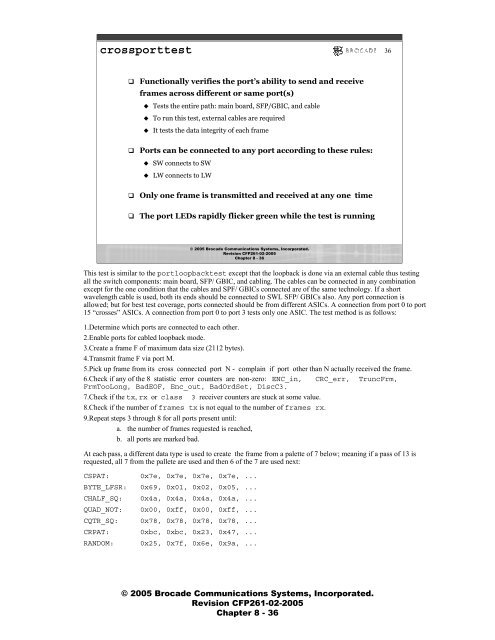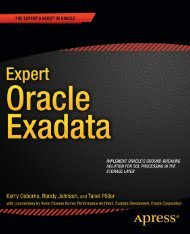Brocade® Product Training
Brocade® Product Training
Brocade® Product Training
You also want an ePaper? Increase the reach of your titles
YUMPU automatically turns print PDFs into web optimized ePapers that Google loves.
crossporttest<br />
36<br />
<br />
<br />
<br />
<br />
Functionally verifies the port’s ability to send and receive<br />
frames across different or same port(s)<br />
Tests the entire path: main board, SFP/GBIC, and cable<br />
To run this test, external cables are required<br />
It tests the data integrity of each frame<br />
Ports can be connected to any port according to these rules:<br />
SW connects to SW<br />
LW connects to LW<br />
Only one frame is transmitted and received at any one time<br />
The port LEDs rapidly flicker green while the test is running<br />
© 2005 Brocade Communications Systems, Incorporated.<br />
Revision CFP261-02-2005<br />
Chapter 8 - 36<br />
This test is similar to the portloopbacktest except that the loopback is done via an external cable thus testing<br />
all the switch components: main board, SFP/ GBIC, and cabling. The cables can be connected in any combination<br />
except for the one condition that the cables and SPF/ GBICs connected are of the same technology. If a short<br />
wavelength cable is used, both its ends should be connected to SWL SFP/ GBICs also. Any port connection is<br />
allowed; but for best test coverage, ports connected should be from different ASICs. A connection from port 0 to port<br />
15 “crosses” ASICs. A connection from port 0 to port 3 tests only one ASIC. The test method is as follows:<br />
1.Determine which ports are connected to each other.<br />
2.Enable ports for cabled loopback mode.<br />
3.Create a frame F of maximum data size (2112 bytes).<br />
4.Transmit frame F via port M.<br />
5.Pick up frame from its cross connected port N - complain if port other than N actually received the frame.<br />
6.Check if any of the 8 statistic error counters are non-zero: ENC_in, CRC_err, TruncFrm,<br />
FrmTooLong, BadEOF, Enc_out, BadOrdSet, DiscC3.<br />
7.Check if the tx, rx or class 3 receiver counters are stuck at some value.<br />
8.Check if the number of frames tx is not equal to the number of frames rx.<br />
9.Repeat steps 3 through 8 for all ports present until:<br />
a. the number of frames requested is reached,<br />
b. all ports are marked bad.<br />
At each pass, a different data type is used to create the frame from a palette of 7 below; meaning if a pass of 13 is<br />
requested, all 7 from the pallete are used and then 6 of the 7 are used next:<br />
CSPAT: 0x7e, 0x7e, 0x7e, 0x7e, ...<br />
BYTE_LFSR: 0x69, 0x01, 0x02, 0x05, ...<br />
CHALF_SQ: 0x4a, 0x4a, 0x4a, 0x4a, ...<br />
QUAD_NOT: 0x00, 0xff, 0x00, 0xff, ...<br />
CQTR_SQ: 0x78, 0x78, 0x78, 0x78, ...<br />
CRPAT: 0xbc, 0xbc, 0x23, 0x47, ...<br />
RANDOM: 0x25, 0x7f, 0x6e, 0x9a, ...<br />
© 2005 Brocade Communications Systems, Incorporated.<br />
Revision CFP261-02-2005<br />
Chapter 8 - 36











